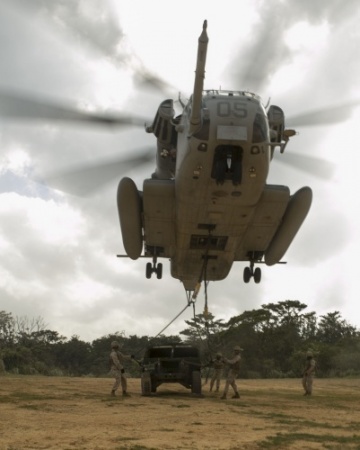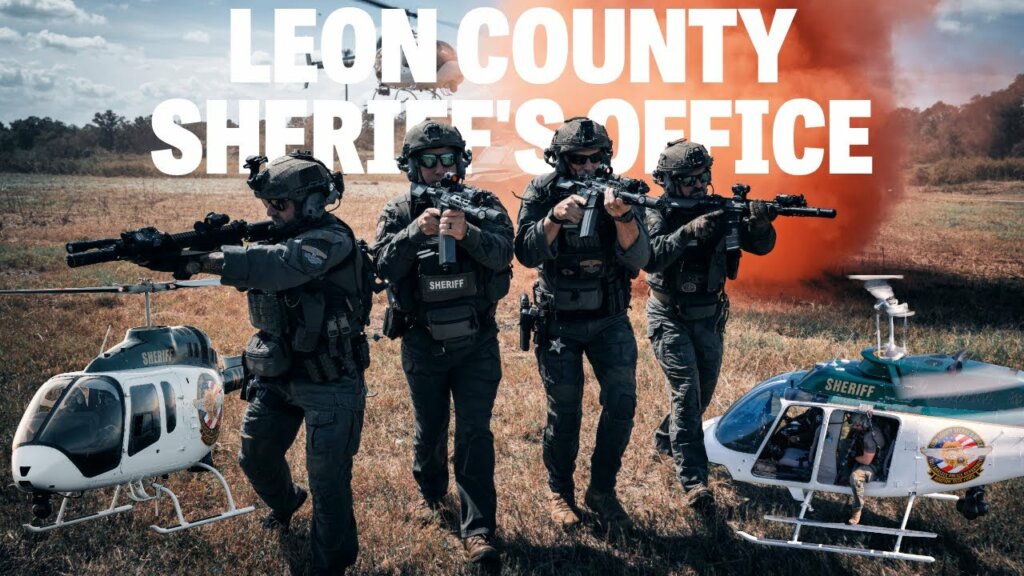
Marines attach hooks from a CH-53E Super Stallion to a Humvee Oct. 7 here. The external-lift training allows the pilot and crew of the CH-53E, and the landing support specialists to hone their skills. To conduct the training, the aircraft was brought to a hover above the Humvee. The Marines below attached the hooks to the harness around the vehicle, allowing the pilot to then lift the heavy load with the aircraft. The Marines are landing support specialists with Combat Logistics Battalion 4, Combat Logistics Regiment 3, 3rd Marine Logistics Group, III Marine Expeditionary Force. The aircraft is with Marine Heavy Helicopter Squadron 361, currently assigned to Marine Aircraft Group 36, 1st Marine Aircraft Wing, III MEF, under the unit deployment program. Cpl. Lena Wakayama Photo/USMC
Marines kneel next to a skeleton of a Humvee, only their eyes visible beneath clear goggles. A CH-53E Super Stallion helicopter approaches the Marines whose bodies are covered with Kevlar helmets, flak jackets, neck gaiters and gloves. As the aircraft approaches, the Marines below fight the torrential winds to complete their mission: Attach the Humvee to the CH-53E.
Marines with Combat Logistics Battalion 4 and Marine Heavy Helicopter Squadron 361 worked together to complete external-lift training Oct. 7 at Landing Zone Dodo here.
External-lift training allows the pilot, aircrews and landing support specialists an opportunity to hone their abilities.
“It’s a pretty simple concept: come to a decent hover over the load, make sure the load is hooked up,” said Capt. Raphael J. Thalakottur, a CH-53E pilot with HMH-361, currently assigned to Marine Aircraft Group 36, 1st Marine Aircraft Wing, III Marine Expeditionary Force, under the unit deployment program.
Although the concept may be simple, a lot needs to happen not only within the aircraft, but also on the ground among the five to nine Marines who make up the loading team.
“There’s the inside and outside director, a leg man, a static man, who grounds the helicopter, and the hook man, who actually hooks the load to the aircraft,” said Lance Cpl. Dallas A. Followill, a landing support specialist with CLB-4, Combat Logistics Regiment 3, 3rd Marine Logistics Group, III Marine Expeditionary Force, and a Quinton, Oklahoma, native.
The inside and outside directors are responsible for directing the aircraft so that it comes to a hover above the load. The static man uses a grounding rod to make sure the static electricity from the helicopter is grounded and does not hurt the Marines. The hook man attaches the harness around the load to the hooks hanging beneath the aircraft, and the leg man ensures the harness does not get caught on anything.
Although the training involved the skeleton of a Humvee, carrying vehicles is not the only thing external lifts are used for, according to Thalakottur.
“We can carry expeditionary bridges that can be placed over water on very short notice,” said Thalakottur. “They’re not necessarily heavy, but (they are) very bulky and cannot be carried by ground transportation without a lot of coordination, whereas a (CH-53E) can come in, hover, pick it up, and take it to its destination.”
For the pilots, the lifts are training they are required to do, but the training is important to the Marines of CLB-4 as well, and not just for the experience.
“Getting under the (aircraft) builds confidence, and not just in knowing (how) to do the lift,” said Cpl. Jonathan M. Floyd, a landing support specialist with CLB-4.
The pilot has to bring the CH-53E low enough to the ground so the Marines can grab hold of the hooks, which means that 15,000-pound aircraft hovers mere feet above their heads.
Most of the Marines in the loading team were veterans of external lifts, but for the few who had never done the training before, it was a unique experience, according to Floyd, a native of Decatur, Illinois.
Many Marines within CLB-4 who are not landing support specialists ask to be a part of the training, according to Floyd.
“They’ve seen (the training) before and they want to do it, because it’s something that they’ve never done and won’t ever get the chance to do,” said Floyd. “People are envious of it.”









